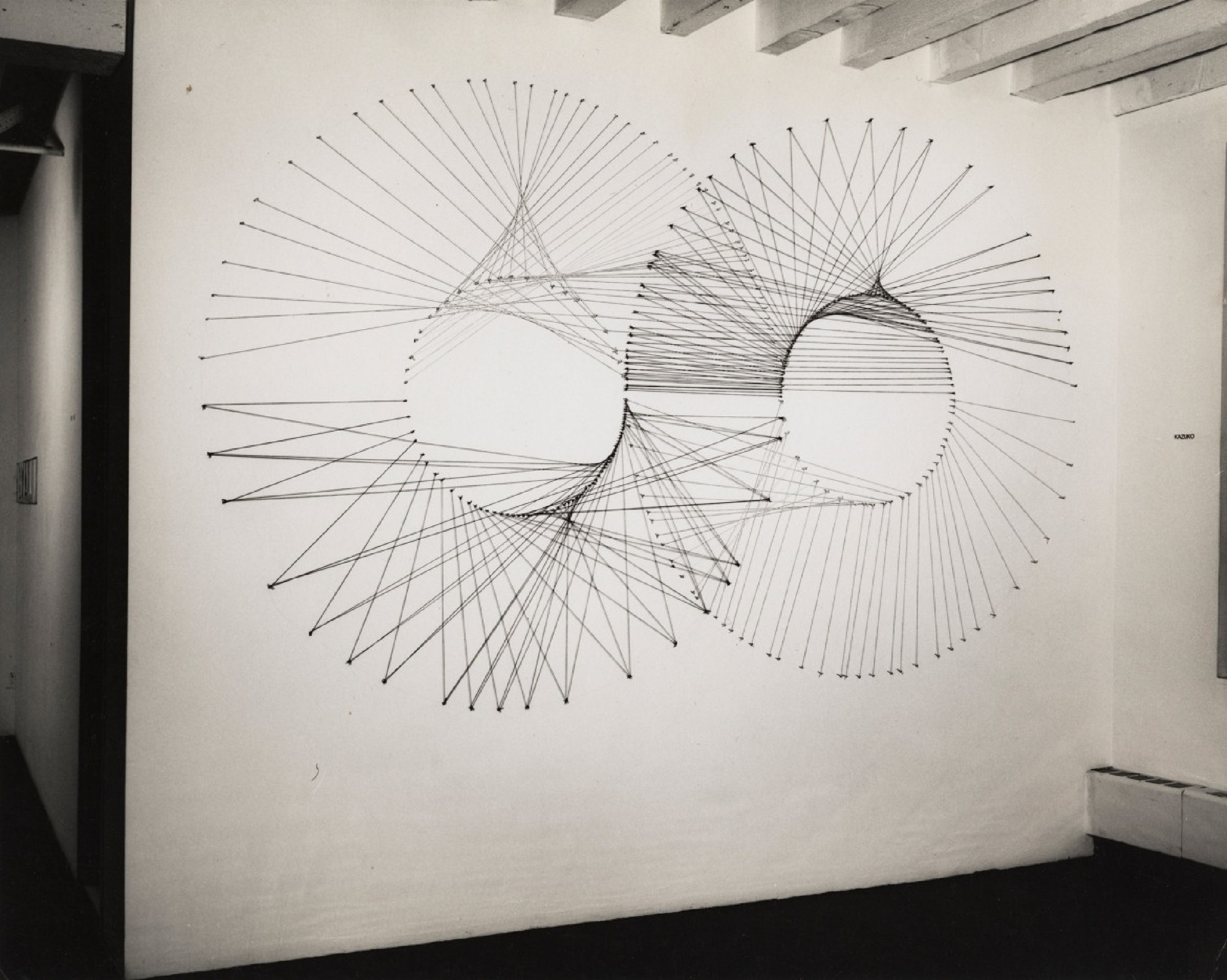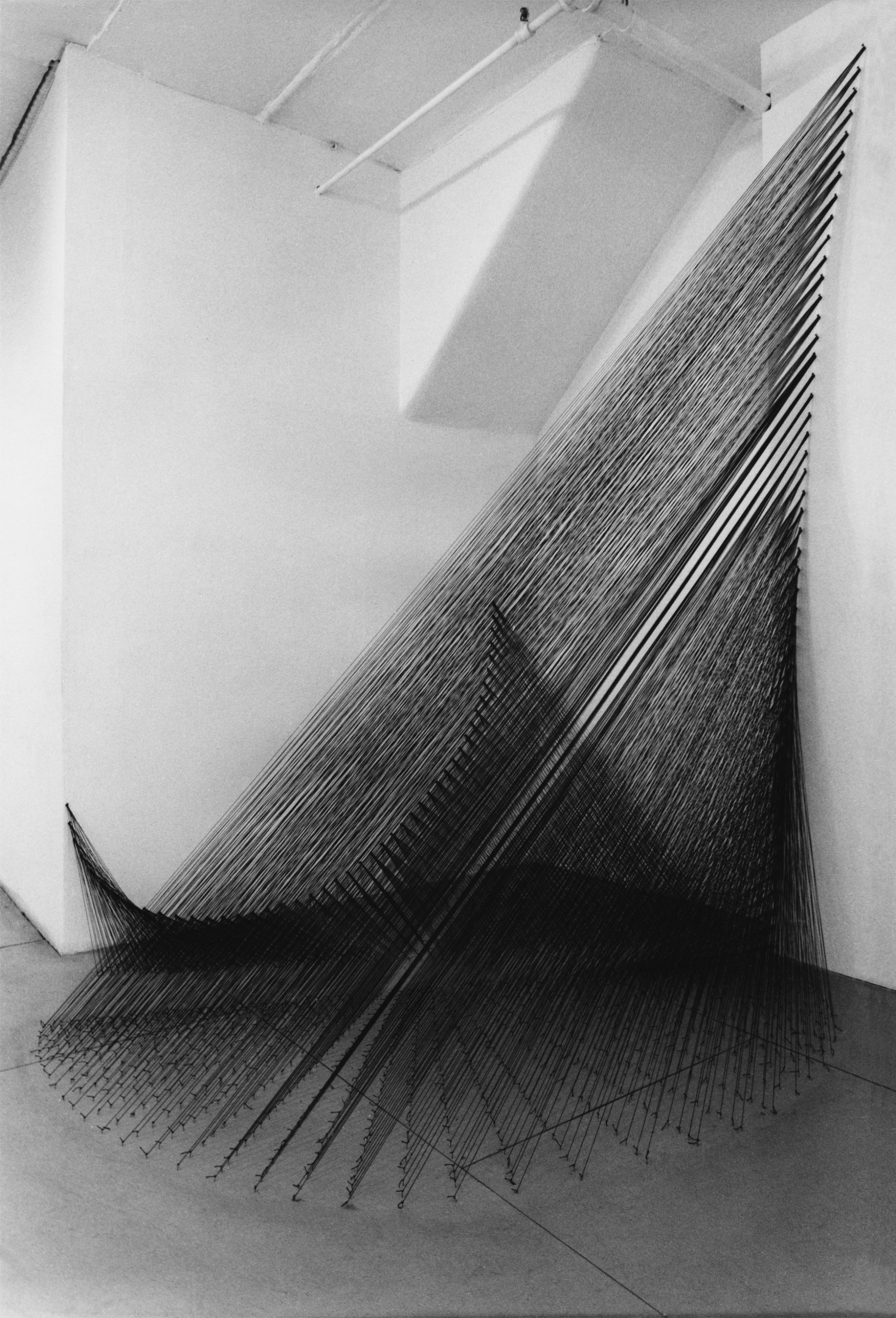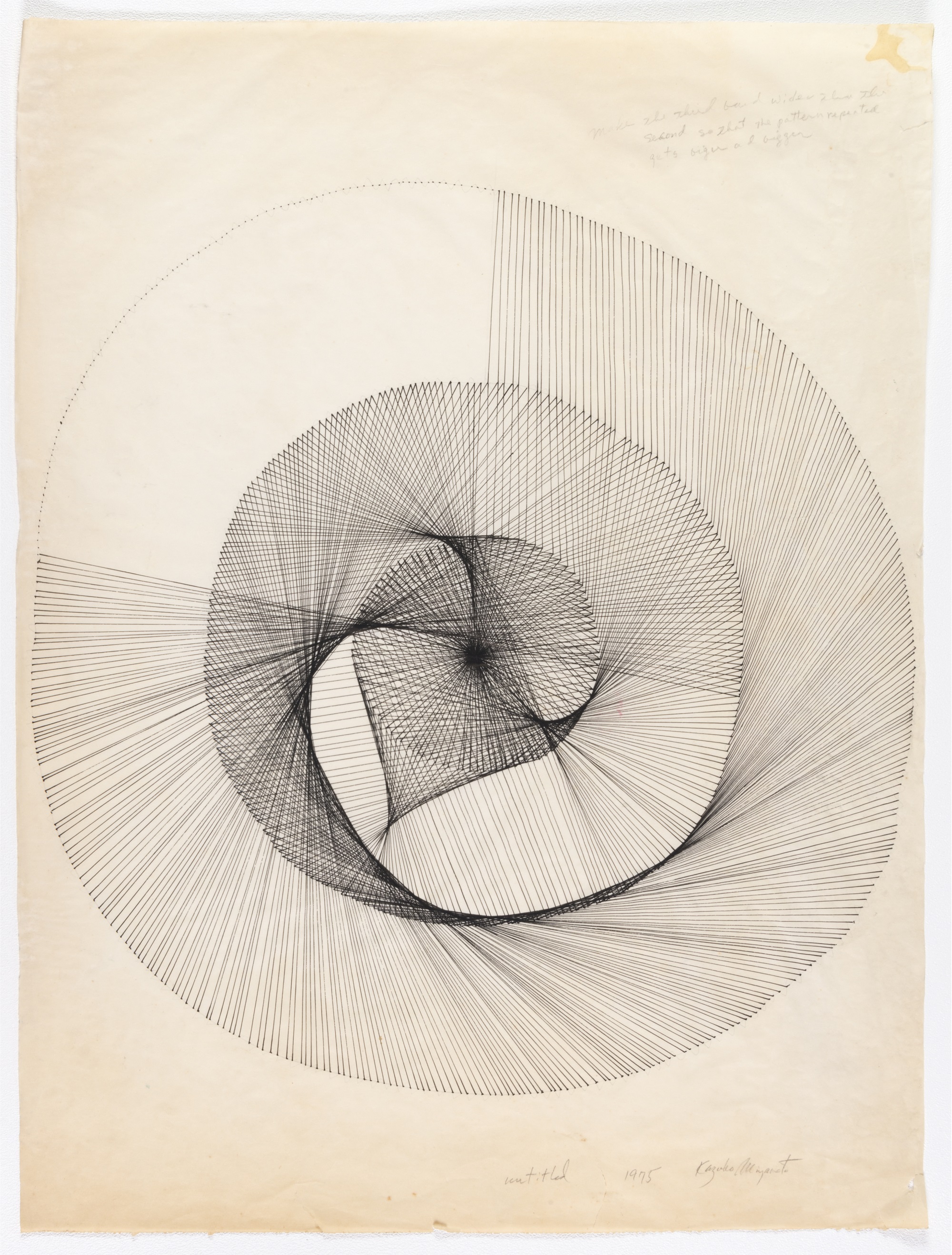宮本和子
Miyamoto Kazuko

無題
1975年
糸、釘
サイズ可変
作家蔵
Untitled
1975
String and nail
Dimensions variable
Collection of the artist
Courtesy: EXILE, Vienna; Take Ninagawa, Tokyo
無題
1975年
糸、釘
サイズ可変
作家蔵
Untitled
1975
String and nail
Dimensions variable
Collection of the artist
Courtesy: EXILE, Vienna; Take Ninagawa, Tokyo

黒い
1979年
糸、釘
サイズ可変
作家蔵
Black Poppy
1979
String and nail
Dimensions variable
Collection of the artist
Courtesy: EXILE, Vienna; Take Ninagawa, Tokyo
黒い 芥子
1979年
糸、釘
サイズ可変
作家蔵
Black Poppy
1979
String and nail
Dimensions variable
Collection of the artist
Courtesy: EXILE, Vienna; Take Ninagawa, Tokyo
《無題》では、無限を指し示す記号、あるいは2つの円を重ねたようにも見える幾何学模様が、黒と白の糸を使って作られています。隣の立体作品《黒い
宮本は1970年代、自身のドローイングをもとに糸と釘の立体作品に取り組みました。当初はシンプルな二次元形体の反復からスタートしましたが、糸を床に伸ばし、《黒い
宮本は、糸という旧来女性のものとされてきた手仕事を連想させる素材を活用し、平面を越えた空間や鑑賞者の身体を取り込むインスタレーションを展開することで、白人男性中心の米国美術界で発展したミニマリズムに新たな解釈を加え、独自の表現を確立したのです。
A geometric pattern, which looks like a figure of infinity symbol or two circles superimposed on each other, is traced in black and white thread in Untitled. In the adjacent three-dimensional work Black Poppy, black thread has been stretched tightly between nails lined up in an arc on two walls, as well as nails lined up on the floor in a circle that has been divided into two. These two works, whose appearance shifts depending on the position of the viewer, are site-specific pieces made using only commercially available thread and nails. More than 300 nails were used for the former, and more than 1900 for the latter.
Miyamoto began working with thread and nails in three-dimensional works based on her own drawings during the 1970s. Starting initially with simple two-dimensional repetitions, she extended the threads to the floor and developed them into more complex three-dimensional forms such as the ones in Black Poppy. These patterns created by the mechanical repetition of handiwork are reminiscent of the wall drawings of Sol LeWitt (1928-2007), a pioneer of minimal and conceptual art, whom she had become close to as an assistant in New York in the late 1960s.
Miyamoto’s use of thread, a material redolent of the handiwork that was traditionally the domain of women, and the development of installations that go beyond the flat surface to incorporate within them the surrounding space and the body of the viewer, have given a new interpretation to the minimalism that developed in the white male-dominated American art world, and established a unique form of expression.

無題
1975年
インク、鉛筆、羊皮紙
62×46 cm
所蔵:デイビット・ヒギンボサム、川野 綾
Untitled
1975
Ink and pencil on vellum
62 x 46 cm
Collection: David Higginbotham and Kawano Aya
Courtesy: Zürcher Gallery, New York/Paris
無題
1975年
インク、鉛筆、羊皮紙
62×46 cm
所蔵:デイビット・ヒギンボサム、川野 綾
1970年代に制作された宮本のドローイング作品は、アーティストによる手作業の跡を強く残しており、精緻な線や大量の文字は作業にかかった膨大な時間を想起させます。彼女の糸と釘の立体作品は、このようなドローイングを設計図として三次元に起こされます。宮本は、幾何学的形態を採用し、作品の構成要素を最小限に抑えるミニマリズムの美学に則りながらも、作り手の身体性や制作にかかる時間を重視した表現に取り組んだことが特徴だといえます。それは、アーティスト個人の痕跡をできる限り排した工業的な制作方法を強調したミニマリズムとは異なるものでした。その後、1980年代に入るとミニマリズム的な作風を離れ、自然素材を用いた有機的な形態のインスタレーションや自らの身体を用いたパフォーマンス作品を展開していきました。
Untitled
1975
Ink and pencil on vellum
62 x 46 cm
Collection: David Higginbotham and Kawano Aya
Courtesy: Zürcher Gallery, New York/Paris
Miyamoto’s drawings from the 1970s display strong traces of the artist’s manual labor. The precise linework and voluminous text evoke the enormous amount of time spent on the work. Her three-dimensional works made out of thread and nails are translated into three dimensions using these drawings as blueprints. Miyamoto’s work might be said to be distinctive for its emphasis on the physicality of the creator and the time it takes to create the work—different from minimalism, which emphasizes industrial production methods, and eliminating traces of the individual artist as much as possible—while also conforming to its aesthetic, in terms of adopting geometric forms and keeping the number of components to a minimum. Later, in the 1980s, Miyamoto moved away from this minimalist style and developed installations with organic forms using natural materials and performance works that used her own body.
アーティスト一覧ARTISTS
- Etel Adnan|エテル・アドナン
- Phyllida Barlow|フィリダ・バーロウ
- Anna Boghiguian|アンナ・ボギギアン
- Miriam Cahn|ミリアム・カーン
- Lili Dujourie|リリ・デュジュリー
- Anna Bella Geiger|アンナ・ベラ・ガイゲル
- Beatriz González|ベアトリス・ゴンザレス
- Carmen Herrera|カルメン・ヘレラ
- Kim Soun-Gui|キム・スンギ
- Suzanne Lacy|スザンヌ・レイシー
- Mishima Kimiyo|三島喜美代
- Miyamoto Kazuko|宮本和子
- Senga Nengudi|センガ・ネングディ
- Nunung WS|ヌヌンWS
- Arpita Singh|アルピタ・シン
- Robin White|ロビン・ホワイト

